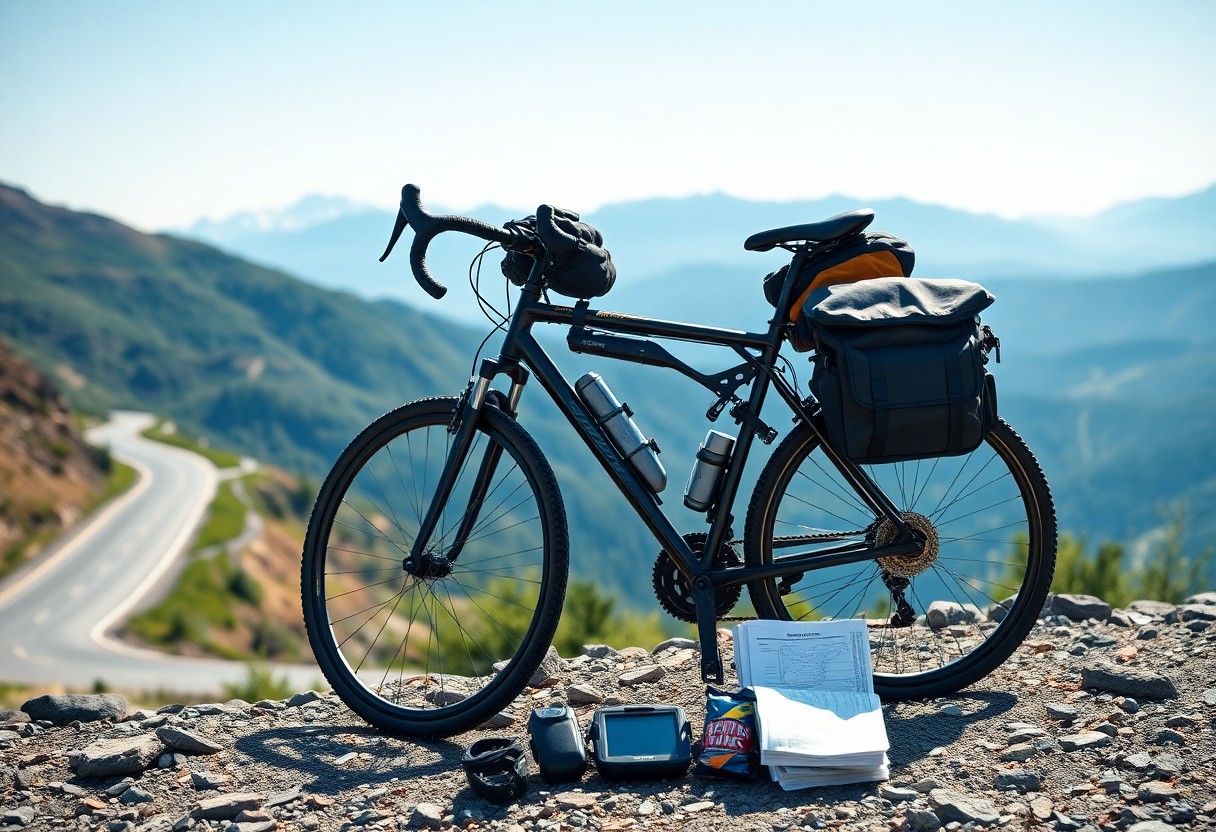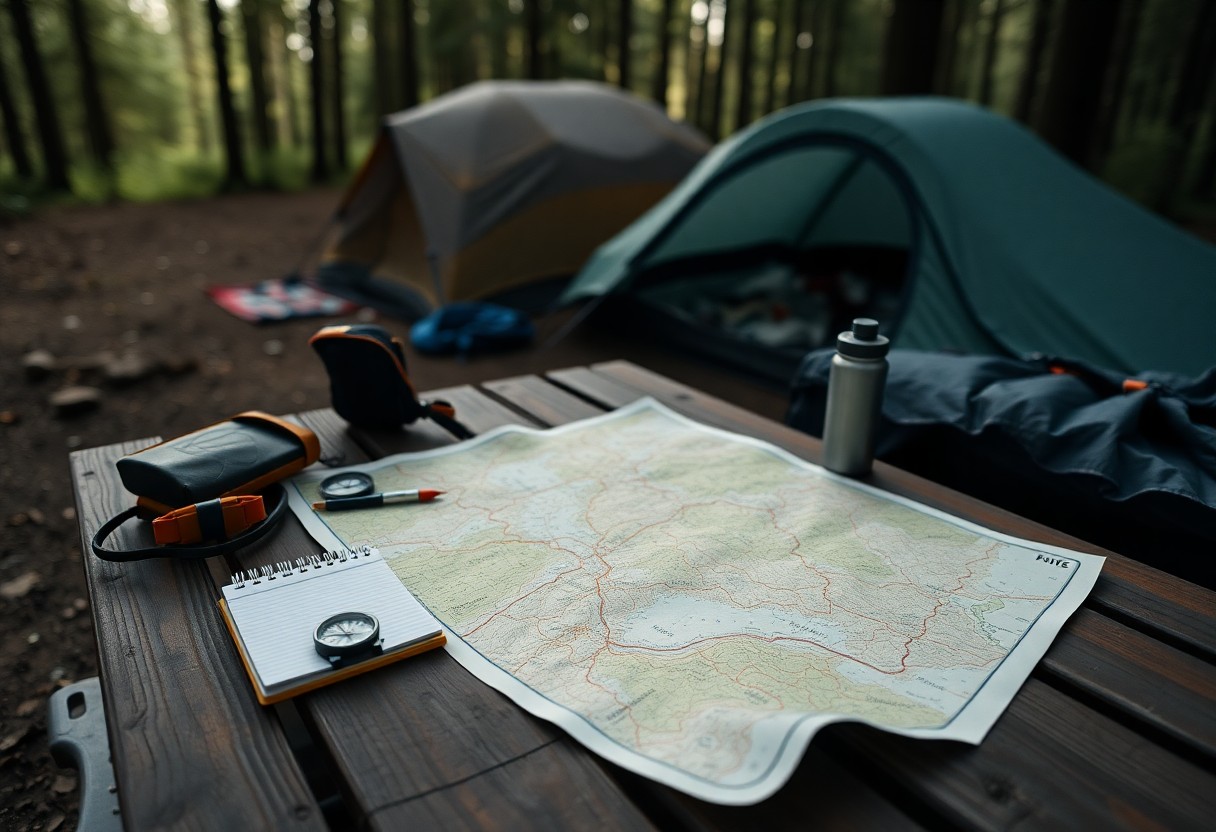Bikepacking opens up a world of adventure, allowing you to explore diverse landscapes while enjoying the freedom of cycling. To plan the ultimate route, you must consider factors such as terrain, distance, and available resources. Ensuring safety is imperative, so always be aware of traffic conditions and potential hazards. By researching local trails and using mapping tools, you can create a journey that balances scenic beauty with practical considerations, making your first bikepacking experience both rewarding and enjoyable.

Key Takeaways:
- Choose manageable distances and terrains to build confidence and ensure a comfortable experience for beginners.
- Incorporate imperative amenities, such as water sources and campsites, to minimise stress and enhance enjoyment during the journey.
- Research local trails and routes thoroughly, considering both navigation options and safety, to create a seamless adventure.
Mapping Your Path: Selecting Destinations
Selecting the right destinations is key to creating an enjoyable bikepacking route that caters to your skill level. Aim for locations that are not only accessible but also provide opportunities for rest and exploration. Look for campsites, towns with amenities, or points of interest that can enrich your experience. Consider planning your route around well-established paths, allowing you to take in the sights while staying safe and comfortable.
Identifying Beginner-Friendly Trails
Beginner-friendly trails should feature gentle gradients and well-maintained surfaces to help you build confidence. Research local bikepacks and cycling apps that offer trail suggestions specifically designed for less experienced riders. This will allow you to gauge the difficulty levels before you set off.
Researching Scenic and Interesting Stops
Adding scenic and intriguing stops to your route not only breaks up your ride but also enhances your overall experience. Seek out natural landmarks, quirky roadside attractions, or historic sites that pique your interest. This not only ensures you enjoy your journey but also provides perfect opportunities for hydration and refreshments.
Look up local tourism sites, social media platforms, or cycling forums for recommendations on must-see attractions along your route. For instance, popular bikepacking destinations may feature local markets, viewpoints, or even craft breweries. Engaging with fellow cyclists can lead to discovering hidden gems and unique spaces that might not be on the mainstream tourist radar. These experiences can create memorable stories to share and can elevate your bikepacking adventure from a mere journey into an exploration filled with discovery.
Essential Gear: Packing for Success
Packing for bikepacking requires a thoughtful approach to ensure a seamless and enjoyable adventure. Consider your itinerary and the expected weather conditions when selecting your gear. A lightweight tent or bivvy bag, sleeping bag, and cooking equipment will form the foundation of your setup. Also, prioritise hydration with a reliable water filtration system and carry extra bottles. To enhance your journey, pack importants like a first aid kit and a multi-tool for any unforeseen repairs.
Must-Have Equipment for Comfort and Safety
Your comfort and safety rely heavily on your equipment choices. A well-fitted bike with sturdy panniers or frame bags will carry your importants without compromising stability. Invest in quality sleeping gear, such as an insulated sleeping pad and a lightweight sleeping bag, to ensure a good night’s rest. A reliable headlight and rear lights bolster safety during low-light conditions, while reflective gear can help you stay visible during unexpected road hazards.
Minimising Weight Without Sacrificing Necessities
Weight minimisation is vital to maintaining stamina throughout your bikepacking journey. Evaluate each item of gear and opt for multi-purpose tools and lightweight materials. Consider packing dehydrated meals instead of heavy canned goods, as they significantly reduce weight while still providing necessary calories. A compact cooking system can also save space and weight, while easily fitting into your panniers. Every gram counts, so make judicious choices to ensure you’re travelling as efficiently as possible.
Focus on the bare importants to keep your load light without leaving behind necessities. For instance, consider a three-in-one tool that serves as a knife, screwdriver, and bottle opener to cut down on the number of individual tools. Opt for clothing made from moisture-wicking materials that are lightweight yet offer versatility for different weather conditions. Each item should earn its place in your pack, helping you maintain both comfort and efficiency as you navigate your bikepacking adventure.
Navigational Strategies: Staying on Track
Proper navigational strategies significantly enhance your bikepacking experience, allowing you to focus on enjoying the journey rather than worrying about getting lost. Relying on a combination of traditional maps and GPS technology enables you to gauge your surroundings and stay oriented. Familiarise yourself with the areas you plan to traverse, while keeping an eye out for landmarks or distinguishing features to help you maintain your bearings throughout your trip.
Techniques for Using Maps and GPS
Utilising both maps and GPS devices offers flexibility in navigating unknown terrain. Start by downloading offline maps to ensure accessibility in areas with poor signal. Track your route using GPS apps like Komoot or Strava, but also develop the skill of reading traditional maps, which can give you a broader sense of the landscape. Combining these methods optimises your ability to recover from unexpected diversions or obstacles.
Understanding Trail Markings and Signage
Trail markings and signage are vital for maintaining your path while bikepacking. They communicate the correct route and provide vital information regarding distances, points of interest, and warnings about challenging sections.
By paying attention to colour-coded markers, you can judge the difficulty level of your route. For instance, blue markers often indicate moderate trails, while red may signify more strenuous paths. Trails may also have supplemental signs that inform you about upcoming hazards, such as steep descents or wildlife encounters. In regions with extensive trail networks, understanding these symbols can prevent you from taking wrong turns or venturing into more difficult terrain by mistake.
Timing and Planning: Scheduling Your Adventure
Optimising your schedule plays a pivotal role in the success of your bikepacking journey. Consider the weather, terrain, and your personal commitments when determining the best time to initiate on your adventure. Planning not just the route, but also when you’ll tackle it, can enhance your experience and ensure you fully enjoy the journey while avoiding less pleasant conditions.
Assessing the Best Seasons for Bikepacking
Different seasons offer unique advantages for bikepacking. Spring and autumn typically present milder weather, ideal for long treks, with less chance of rain and manageable temperatures. Summer may be popular, but heat can lead to exhaustion, while winter presents its own challenges. Carefully evaluate local climates to pinpoint the time that aligns with your fitness level and preferences.
Estimating Daily Distances and Breaks
Setting realistic daily distances is crucial for a fulfilling bikepacking experience. As a beginner, start with 30 to 50 miles per day, adjusting based on your fitness and bike handling skills. Factor in the terrain, weather conditions, and any potential detours that may arise. Incorporating breaks, not just for meals but for rest and hydration, plays a vital role in preventing fatigue and maintaining your enthusiasm throughout the trip.
Allocate time for both short breaks and longer meal stops to rejuvenate during your bikepacking days. A good rule of thumb is to cycle for two hours and then take a 15-minute break. For longer rides, an extended lunch break of at least 30 minutes can significantly enhance your stamina. Monitor how your body reacts as you progress, adjusting daily distances as necessary to ensure you’re not overwhelmed, making the experience more enjoyable.
Safety First: Preparing for the Unexpected
Being prepared for unforeseen circumstances ensures your bikepacking adventure remains enjoyable. Equip yourself with the imperative items for emergencies, keep a first aid kit handy, and always inform someone about your route and expected return time. Having a reliable multi-tool and spare tubes can be a lifesaver in case of mechanical issues. Ensure you have sufficient provisions and a backup plan should you encounter any sudden weather changes or accidents.
Emergency Protocols and Preparedness Tips
Establishing clear emergency protocols can make all the difference in a challenging situation. Carry a fully charged mobile phone and a portable charger, as these can provide a vital lifeline. Know the location of the nearest medical facilities and keep emergency contacts saved in your device. Always have a well-stocked first aid kit that includes items for treating cuts, scrapes, and more serious injuries. Ensure your bike is maintained properly to minimise chances of breakdowns. After creating your emergency plan, practice it with your riding companions to ensure everyone is prepared.
Building an Awareness of Your Surroundings
Your ability to recognise and respond to your environment can enhance both your safety and enjoyment while bikepacking. Stay alert to potential hazards, including changes in weather, terrain irregularities, and animal crossings. Regularly glance at your surroundings to identify points of interest, safe resting spots, and routes to emergency exits. Engaging all your senses heightens your awareness and prepares you to navigate any unexpected challenges that may arise during your journey.
Building an understanding of your surroundings involves not just observing, but also learning to interpret the information presented by nature. For instance, dark clouds may hint at incoming rain, requiring you to adjust your route or find shelter. Noticing the behaviour of wildlife can alert you to environmental conditions, such as nearby water sources or steep descents. By immersing yourself in the moment, you cultivate a higher level of awareness, allowing you to respond effectively to whatever unfolds on your adventure.
Conclusion
On the whole, planning the ultimate bikepacking route for beginners requires careful consideration of your physical ability, the terrain, and the distance you aim to cover. Begin by selecting well-maintained trails with clear signage and ample resources such as campsites and water sources. Break your journey into manageable sections, allowing time for rest and exploration. Make sure to prepare for weather conditions and pack important supplies. By taking these steps, you can ensure a rewarding and enjoyable bikepacking experience that fosters your love for the outdoors.
FAQ
Q: What are the key considerations when planning a bikepacking route for beginners?
A: When planning a bikepacking route for beginners, several key considerations should be taken into account. First, assess the fitness level and experience of the riders; it’s imperative to choose terrain and distances that match their capabilities. Focus on including bike-friendly paths, such as well-maintained gravel roads or marked bike trails, to ensure a smoother riding experience. Additionally, consider the availability of camping spots and resources along the route, including water sources and facilities. Plan your route in segments, ensuring that daily distances are manageable, allowing for breaks and exploration.
Q: How can I ensure that the route is safe and enjoyable for beginners?
A: To ensure the route is safe and enjoyable for beginners, it’s important to do some research beforehand. Look for user reviews and recommendations from fellow bikepackers on popular routes. Opt for trails and roads with lower traffic volumes to minimise the risk associated with vehicles. Also, choose well-marked trails with clear signage to aid navigation. Incorporate stops at points of interest, such as scenic views or historical landmarks, to enrich the experience. Lastly, be prepared for emergencies by packing a basic first-aid kit and ensuring each rider has a reliable means of communication.
Q: What resources are available to help plan an ideal bikepacking route for beginners?
A: There are numerous resources available to help plan an ideal bikepacking route for beginners. Online platforms such as Komoot, RideWithGPS, and Strava can be invaluable for mapping out routes and discovering popular trails. Additionally, cycling forums and social media groups often share personal experiences and recommendations for beginner-friendly routes. Guidebooks focused on bikepacking in your region can provide detailed insights into trails, terrain, and amenities. Don’t hesitate to reach out to local cycling clubs for advice and tips tailored to your area, as they can offer firsthand knowledge and suggestions for routes that are suitable for new bikepackers.
